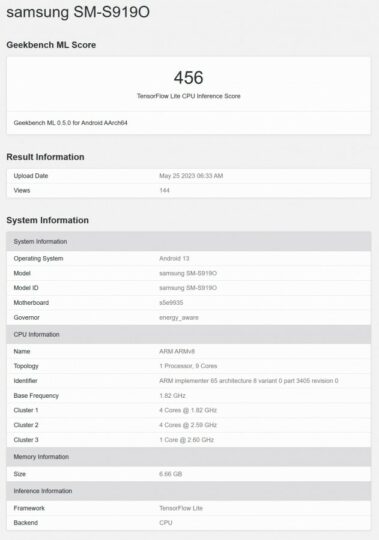A mysterious unreleased Samsung device is now making the rounds on the so-called blogosphere after it popped up in the Geekbench machine learning (ML) benchmark. And everyone appears to be making a big deal about it. Why is that? And is the hubbub justified?
What got everyone so worked up about this Geekbench entry is that the device under testing appears to be powered by the Exynos 2300 chipset. The Exynos 2300 is believed to have been canceled, so seeing it in action seems unusual.
Then, some speculate maybe a bit too much and go a step further into saying that the mysterious device (SM-S919O) could be the upcoming Galaxy S23 FE. Put two and two together, and you get an exciting benchmark entry for the Galaxy S23 FE rocking the Exynos 2300 SoC. However, it's not that simple, and it's most likely an inaccurate assessment. So let's dive deeper into what all this could mean.
This most likely isn't the Galaxy S23 FE, and it may not concern a commercial device
First things first, this seems to be the perfect time to remember that even though most Geekbench entries are legitimate, the benchmark is not infallible. Fake benchmark entries existed before, as it is possible to fake the identity of a device and pass it off as something entirely different.
With that important caveat out of the way, what does the SM-S919O benchmark tell us? Well, first of all, it tells us that this shouldn't be the Galaxy S23 FE. The Fan Edition device is known to have model number SM-S711x. So the only way this is the Galaxy S23 FE is if Samsung wanted to hide its identity, which is doubtful. It's more likely that we're looking at a fabricated benchmark entry, i.e., a fake device made to fool Geekbench into saying whatever the originator wants it to say.
Another thing the benchmark tells us is that the mysterious device features a 9-core chip boasting an Xclipse 930 GPU — the successor to the existing Xclipse 920 found on the Exynos 2200 SoC.
In addition, the benchmark entry suggests that the device oddly runs an old firmware version (S919OXXU0AVI1) that corresponds to September 2022. The date is hidden in plain sight if you know how to read Samsung's firmware numbers. The letter “V” corresponds to 2022, and the letter “I” translates to September. Needless to say, Samsung using such old firmware for what would be an upcoming Fan Edition phone powered by a new chipset is highly unusual.
And finally, the benchmark suggests that the mysterious device and its chipset are pretty awful at performing ML (machine learning) tasks. A score of 456 points for a next-gen chip is fairly low, given that the Galaxy S23 already achieves around 600 points. So, again, this could indicate that a completely different device might be hiding beneath all this surface-level (faked) information anyone can see in Geekbench.
So where does all this leave us? What is the SM-S919O? Well, aside from the possibility of it being a completely fake and fabricated Geekbench entry, there is another option. Namely, this could be a hardware test bench for the unreleased and canceled Exynos 2300 SoC that a Samsung engineer dusted off for some reason and decided to test using Geekbench. It might be a device Samsung never meant to commercialize but used to test the chipset. But then, why the engineer would go to the lengths of seemingly changing the model number to SM-S919O is unclear.
All in all, our guess is that the Geekbench entry is most likely fake, and there's no Exynos 2300 or SM-S919O here hiding beneath the information provided through the benchmark. Nevertheless, stranger things have happened. So, at the most, this could be an Exynos 2300 test bench or a prototype device running the Geekbench ML test somewhere in Samsung's labs for reasons unknown.
Regardless of where the truth lies, this benchmark certainly doesn't convince us that the Exynos 2300 chip is on its way. As far as we can tell, nothing's changed. The Exynos 2300 chip was in development last year, but Samsung canned it, and the SoC will never see the light of day in a commercial device.







